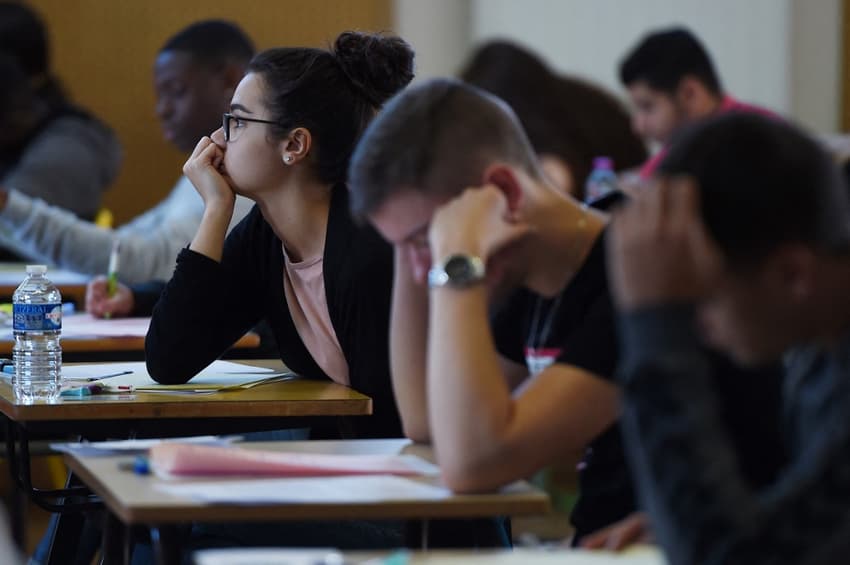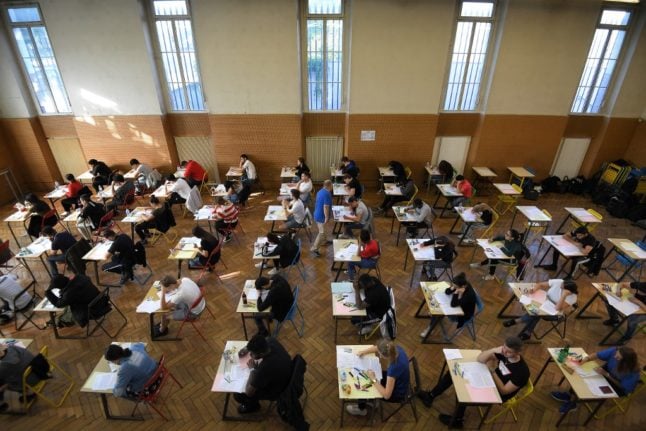EXPLAINED: How Spain is overhauling its university entrance exams

The Spanish government has announced major changes to Spain’s university entrance exams, including fewer tests, no stand-alone foreign language test and more focus on ‘academic maturity’.
Pedro Sánchez’s PSOE-fronted coalition government is set to overhaul the Spanish selectividad process (also known as EBAU) for entry into university, something akin to a UCAS application in the U.K, or SAT tests in the U.S.
The changes halve the number of mandatory exams students need to take, and instead focus the thrust of the application around an ‘academic maturity test’ designed to encourage critical thinking, changes that have been derided by some newspapers, unions and associations in Spain as a ‘dumbing down’ of the process and major modifications that have been rushed out.
From the 2026/2027 academic year, the ‘academic maturity test’ will count for 75 percent of the final exams, and replace the traditional exams on the history of Spain and history of philosophy, with the remaining 25 percent taken from subjects chosen by the students.
In terms of the overall grades and university application itself, 40 percent will be determined by the new exam format, and the other 60 percent by the student’s overall Baccalaureate file - equivalent to A-levels in the U.K and the GPA (grade point average) in the U.S.
The maximum score that can be reached will be 10.
With the new system students will take between two and four exams, with the minimum being just two: the maturity test, a test chosen from the pool of core subjects (including Maths, Sciences, and Arts) plus two elective tests, which are voluntary and students can choose the subjects.
The proposed changes, set to be presented to Spain’s autonomous communities and universities this week by the Ministry of Education, outline a lengthy transitional period for students, teachers, and university faculties to adapt to the new way of learning, teaching, and, crucially, test taking.
The implementation of the new selectividad will be gradual and enter into force by the 2026/2027 academic year. The transitional model will be in force in the 2023/2024, 2024/2025 and 2025/2026 academic years.
The reforms represent the largest reform of the university access system since it was created almost 50 years ago, and follows recent changes to Spain’s ‘ESO’ system.
READ ALSO: How Spain is changing its ESO secondary education system

One long held criticism of Spain's university entrance system has been the number of exams, up to a maximum of nine. (Photo by FREDERICK FLORIN / AFP)
Academic maturity test
The new ‘academic maturity test’ - which can be understood as encompassing critical thinking, reasoning and good judgement - will be made up of several sources including texts, images, infographics, and audiovisuals. Each student or applicant will do the same test, which may be topical, scientific, linguistic, or humanities-based, and the test will be divided into three parts.
The first part will be intended for "reading and analysis" of the documents and will last just 15 minutes. The second part will include a series of "closed or semi-constructed" questions that will be aimed at testing the "capacity for critical thinking, reflection and maturity" of the students.
Two or three of these questions will be asked in a foreign language, most probably English, and this question and answer section will last for around 40 minutes.
However, according to Ministry of Education documents circulating in the Spanish press this week, the changes mean there will be no stand-alone foreign language exam.
READ ALSO: What are the rules and costs for foreigners who want to go to university in Spain?
The third and final part of the test will consist of three open-ended questions (of which one will be in a foreign language) about the sources, and is designed to encourage critical thinking with "a single unequivocal correct answer". It will last 45 minutes.
In recent decades, several Spanish governments promised reform on the university entrance process, but no substantial changes ever materialised.
One long held criticism of the system has been the number of exams, up to a maximum of nine.
Among foreigners, another perceived weakness of the selectividad - and the Spanish education system more broadly - is that the style of teaching and learning is anchored by a very memory-based, rote-learning approach.
The ‘academic maturity’ test, therefore, is intended to encourage teachers and students to place greater emphasis on critical thinking as opposed to memorising topics or texts purely for the purpose of passing exams.
Comments
See Also
Pedro Sánchez’s PSOE-fronted coalition government is set to overhaul the Spanish selectividad process (also known as EBAU) for entry into university, something akin to a UCAS application in the U.K, or SAT tests in the U.S.
The changes halve the number of mandatory exams students need to take, and instead focus the thrust of the application around an ‘academic maturity test’ designed to encourage critical thinking, changes that have been derided by some newspapers, unions and associations in Spain as a ‘dumbing down’ of the process and major modifications that have been rushed out.
From the 2026/2027 academic year, the ‘academic maturity test’ will count for 75 percent of the final exams, and replace the traditional exams on the history of Spain and history of philosophy, with the remaining 25 percent taken from subjects chosen by the students.
In terms of the overall grades and university application itself, 40 percent will be determined by the new exam format, and the other 60 percent by the student’s overall Baccalaureate file - equivalent to A-levels in the U.K and the GPA (grade point average) in the U.S.
The maximum score that can be reached will be 10.
With the new system students will take between two and four exams, with the minimum being just two: the maturity test, a test chosen from the pool of core subjects (including Maths, Sciences, and Arts) plus two elective tests, which are voluntary and students can choose the subjects.
The proposed changes, set to be presented to Spain’s autonomous communities and universities this week by the Ministry of Education, outline a lengthy transitional period for students, teachers, and university faculties to adapt to the new way of learning, teaching, and, crucially, test taking.
The implementation of the new selectividad will be gradual and enter into force by the 2026/2027 academic year. The transitional model will be in force in the 2023/2024, 2024/2025 and 2025/2026 academic years.
The reforms represent the largest reform of the university access system since it was created almost 50 years ago, and follows recent changes to Spain’s ‘ESO’ system.
READ ALSO: How Spain is changing its ESO secondary education system

Academic maturity test
The new ‘academic maturity test’ - which can be understood as encompassing critical thinking, reasoning and good judgement - will be made up of several sources including texts, images, infographics, and audiovisuals. Each student or applicant will do the same test, which may be topical, scientific, linguistic, or humanities-based, and the test will be divided into three parts.
The first part will be intended for "reading and analysis" of the documents and will last just 15 minutes. The second part will include a series of "closed or semi-constructed" questions that will be aimed at testing the "capacity for critical thinking, reflection and maturity" of the students.
Two or three of these questions will be asked in a foreign language, most probably English, and this question and answer section will last for around 40 minutes.
However, according to Ministry of Education documents circulating in the Spanish press this week, the changes mean there will be no stand-alone foreign language exam.
READ ALSO: What are the rules and costs for foreigners who want to go to university in Spain?
The third and final part of the test will consist of three open-ended questions (of which one will be in a foreign language) about the sources, and is designed to encourage critical thinking with "a single unequivocal correct answer". It will last 45 minutes.
In recent decades, several Spanish governments promised reform on the university entrance process, but no substantial changes ever materialised.
One long held criticism of the system has been the number of exams, up to a maximum of nine.
Among foreigners, another perceived weakness of the selectividad - and the Spanish education system more broadly - is that the style of teaching and learning is anchored by a very memory-based, rote-learning approach.
The ‘academic maturity’ test, therefore, is intended to encourage teachers and students to place greater emphasis on critical thinking as opposed to memorising topics or texts purely for the purpose of passing exams.
Join the conversation in our comments section below. Share your own views and experience and if you have a question or suggestion for our journalists then email us at [email protected].
Please keep comments civil, constructive and on topic – and make sure to read our terms of use before getting involved.
Please log in here to leave a comment.